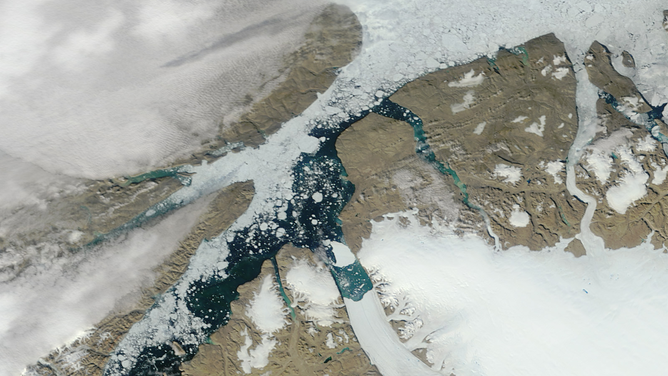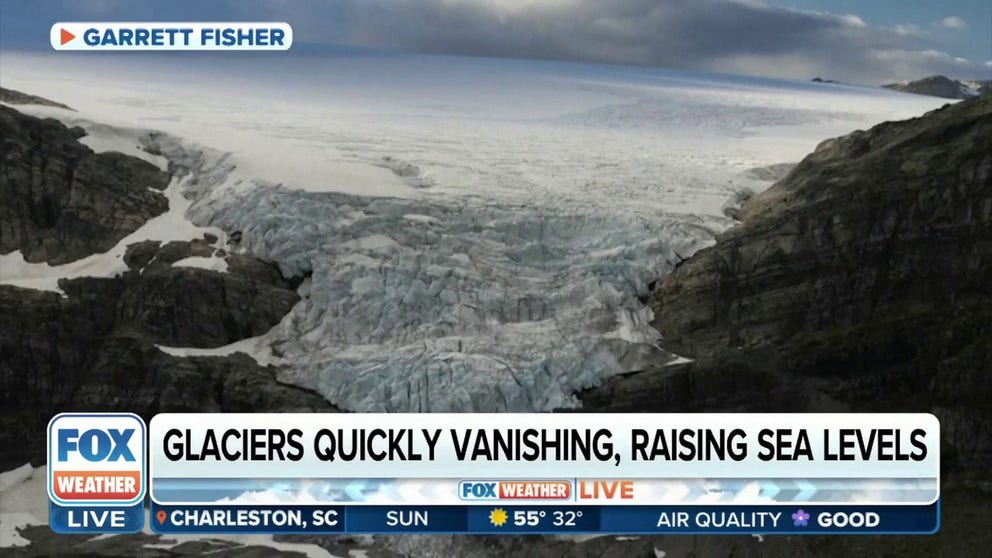Greenland glacier melting faster than previously thought: Here's what that means for future sea-level rise
By using satellite and radar data, the scientists said they learned that the Petermann Glacier’s grounding line, which is the location in which ice detaches from the land and begins to float in the ocean, has been shifting during tidal cycles and is allowing warm seawater to melt the ice at an accelerated rate.
Watch: UN secretary-general warns 'humanity is on thin ice' when it comes to reversing effects of climate change
United Nations Secretary-General Antonio Guterres warns humanity is on thin ice, and that ice is melting fast when it comes to reversing the devastating and deadly effects of climate change around the world. Guterres released this video message ahead of a press conference to launch the Synthesis Report of the Intergovernmental Panel on Climate Change on Monday.
GREENLAND – Researchers studying a glacier in remote northwestern Greenland said they found that it’s melting faster than previously thought, which could mean that the climate community has been underestimating the magnitude of future sea-level rise.
The findings were published Monday in the Proceedings of the National Academy of Sciences and uncovered a previously unseen way in which the ice and ocean interact.

FILE - In July 2012, a massive ice island broke free of the Petermann Glacier in northwestern Greenland. On July 16, the giant iceberg could be seen drifting down the fjord, away from the floating ice tongue from which it calved.
(NASA Earth Observatory image by Jesse Allen and Robert Simmon, using data from NASA/GSFC/METI/ERSDAC/JAROS, and U.S./Japan ASTER Science Team. Caption by Michon Scott. / NASA)
By using satellite and radar data, the scientists said they learned that the Petermann Glacier’s grounding line, which is the location in which ice detaches from the land and begins to float in the ocean, has been shifting during tidal cycles and is allowing warm seawater to melt the ice at an accelerated rate.
According to the study, when the grounding line retreated by about 2.3 miles between 2016 and 2022, it carved a cavity nearly 670 feet high – taller than The Gateway Arch in St. Louis.
"The glacier has not recovered from that retreat, and the ocean waters keep enlarging the size of that cavity," study co-author and University of California, Irvine, (UCI) professor of Earth system science and NASA Jet Propulsion Laboratory research scientist Eric Rignot told FOX Weather. "The water is regularly flushed in and out of the cavity by the ocean tides, which makes the matter worse."
GLACIERS MELTED FASTER THAN AVERAGE IN 2022 AS OCEANS ROSE AND WARMED, SCIENTISTS SAY

FILE - The giant iceberg that broke off Greenland’s Petermann Glacier in mid-July 2012 continued moving down the fjord at the end of the month. The Moderate Resolution Imaging Spectroradiometer (MODIS) on NASA’s Terra satellite captured this natural-color image on July 30, 2012. By the time MODIS acquired this image, the iceberg—named PII-2012—had traveled roughly 22 kilometers (14 miles) from the edge of the Petermann Glacier and had rotated counter-clockwise.
(NASA image courtesy Jeff Schmaltz, LANCE MODIS Rapid Response Team at NASA GSFC. Caption by Michon Scott. / NASA)
The study said Greenland lost billions of tons of ice to the ocean in the past few decades due to the warming of subsurface ocean waters.
"The new insights about the processes controlling glacier melt by the ocean around the periphery of Greenland suggest that projections of sea-level rise from land ice melt are too low, possibly by a factor of two," Rignot added.
Study lead author Enrico Ciraci, a UCI assistant specialist in Earth system science and NASA postdoctoral fellow, said that the traditional view of grounding lines under the ocean-reaching glaciers was that they did not migrate during tidal cycles and didn’t experience ice melt.
Glaciers are melting faster than scientists' forecast
Glaciers across the world are melting at a faster rate than scientists had expected. One photographer it taking to the sky to make sure future generations can still enjoy them.
The new study replaces that traditional view.
"Petermann’s grounding line could be more accurately described as a grounding zone because it migrates between 2 and 6 kilometers (between 1.2 and 3.7 miles) and as the tides come in and out," he said in a news release.
It’s now believed that the warm ocean water is getting under the ice through preexisting subglacial channels, and the highest melting rates are occurring at the grounding zone.
"This is an order of magnitude larger than expected for grounding lines on a rigid bed," Ciraci added.

